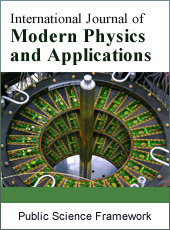International Journal of Modern Physics and Applications
Articles Information
International Journal of Modern Physics and Applications, Vol.1, No.3, Jul. 2015, Pub. Date: Jul. 16, 2015
Prediction of Turbulent Flow Characteristics in Asymmetric Sudden Expansion Using Linear and Non-Linear Turbulence Models
Pages: 118-130 Views: 3153 Downloads: 1860
[01]
A. Balabel, Mechanical Engineering Department, Faculty of Engineering, Taif University, Taif, Saudi Arabia; Mechanical Power Engineering Department, Faculty of Engineering, Menoufiya University, Shebin El-Kom, Egypt.
[02]
W. A. El-Askary, Mechanical Power Engineering Department, Faculty of Engineering, Menoufiya University, Shebin El-Kom, Egypt.
Recently, various turbulence models are widely developed in order to present a good prediction of turbulent characteristics in a wide range of industrial and engineering applications. Since the linear eddy-viscosity models show a poor prediction for some modern applications and their assumptions become invalid for separated flows, the non-linear eddy viscosity models become an important topic in the recent modeling of turbulent separated flow. The non-linear eddy viscosity models are expected to give a better prediction of reattaching turbulent flow as a result of the non-linear constitutive stress-strain relationship proposed to extend the applicability of the linear-eddy viscosity models. In the present paper, different linear and non-linear turbulence models are applied to predict one of the most complex geometry turbulent flows; namely, turbulent flow in asymmetric divergent channel. The abilities of these models to predict the turbulent flow characteristics in such complex geometry are examined and investigated numerically by solving Reynolds-averaged Navier-Stokes equations using the finite volume approach. The computed results are compared with the available experimental data in literature. The comparison of the obtained results with the experimental data has showed that the non-linear models have a better prediction, for the separated region and the associated turbulent characteristics, than the linear models. Consequently, the non-linear turbulence models could be considered as a powerful and a reliable tool in predicting such complex turbulent flows.
Asymmetric Sudden Expansion, Non-Linear Turbulence Models, Numerical Simulation, Separated Turbulent Flow
[01]
A. Balabel, W.A. El-Askary, On the Performance of Linear and Nonlinear k–ε Turbulence Models in Various Jet Flow Applications, European Journal of Mechanics B/Fluids. Vol. 30, pp. 325-340, 2011.
[02]
A. Balabel, Numerical Modeling of Turbulence-Induced Interfacial Instability in Two-Phase Flow with moving Interface. Applied Mathematical Modeling, Vol. 36 (8), pp. 3593-3611, 2012.
[03]
W. A. El-Askary, M. El-Mayet, A. Balabel, On the Performance of Sudden-Expansion Pipe without/with Cross-Flow Injection: Experimental and Numerical Studies, International Journal for Numerical Methods in Fluid. Vol. 69, pp. 366–383, 2012.
[04]
B. E. Launder, D. B. Spalding, Mathematical Models of Turbulence, Lectures Notes, Imperial College of Science and Technology, London, England, 1972.
[05]
B. E. Launder, D. B. Spalding, The Numerical Computation of Turbulent Flows, International Journal for Numerical Methods in Fluids, Vol. 15, pp. 127-146, 1974.
[06]
D. C. Wilcox, Turbulence Modeling for CFD, DCW Industries, La Canada, California, 1998.
[07]
V. Yakhot, S. A. Orzag, Renormalization Group Analysis of Turbulence. I. Basic Theory, Journal of Scientific Computing, Vol. 1, pp. 3-51, 1986.
[08]
F. R. Menter, Two-Equation Eddy-Viscosity Turbulence Models for Engineering Applications, AIAA Journal, Vol. 32(8), pp. 1598-1605, 1994.
[09]
K. Chien, Predictions of Channel and Boundary Layer Flows with a Low-Reynolds-Number Turbulence Model, AIAA Journal, Vol. 20, pp. 33-38, 1982.
[10]
W. Rodi, J. C. Bonnin, T. Buchal, Proceedings of the ERCOFTAC Workshop on Data Bases and Testing of Calculation Methods for Turbulent Flows, University of Karlsruhe, Germany, 1995.
[11]
V. Yakhot, L. M. Smith, The Renormalization Group, the Epsilon-Expansion and Derivation of Turbulence Models, Journal of Scientific Computing, Vol. 7, pp. 35-51, 1992.
[12]
K. Shimada, Application of a Modified k-ε Model to the Prediction of Aerodynamic Characteristics of Rectangular Cross-Section Cylinders, Journal of Fluids and Structures, Vol. 16(4), pp. 465-485, 2001.
[13]
J. Abraham, V. Magi, Computations of Transient Jets: RNG k- ε Model Versus Standard k- ε Model, SAE Technical paper 970885, 1997.
[14]
S. B. Pope, A more General Effective-Viscosity Hypothesis, Journal of Fluid Mechanics, Vol. 72, pp. 331-340, 1975.
[15]
T. J. Craft, B. E. Launder, K. Suga, Development and Application of a Cubic Eddy-Viscosity Model of Turbulence, International Journal of Heat and Fluid flow, Vol. 17, pp. 108-115, 1996.
[16]
D. D. Apsley, M. A. Leschziner, A New Low Re Non-Linear Two-Equation Turbulence Model for Complex Flows, Proc. 11th Symposium on Turbulent Shear Flows, Grenoble, 1997.
[17]
B.E. Launder, B. I. Sharma, Application of the Energy-Dissipation Model of Turbulence to the Calculation of Flow near a Spinning Disc. Letters in Heat and Mass Transfer, Vol. 1, pp. 131-138, 1974.
[18]
T. J. Craft, B. E. Launder, K. Suga, Prediction of Turbulent Transitional Phenomena with a Non-Linear Eddy-Viscosity Model, International Journal of Heat Fluid Flow, Vol. 18, pp. 15-28, 1997.
[19]
F. S. Lien, W. L. Chen, M. A. Leschziner, Low-Reynolds-Number Eddy-Strain-Viscosity Modeling Based on Non-linear Stress-Strain/Vorticity Relations. Proceedings of the Third International Symposium of Engineering Turbulence Modeling and Measurements, Crete, 1996.
[20]
D. M. Driver, H. L. Seegmiller, Features of Reattaching Turbulent Shear Layer in Divergent Channel flow, AIAA Journal, Vol. 23(2), pp. 163-171, 1985.
[21]
R. W. Benodekar, A. J. Goddard, A. D. Gosman, R. I. Issa, Numerical Prediction of Turbulent Flow over Surface-Mounted Ribs, AIAA Journal, Vol. 23(3), pp. 359-366, 1985.
[22]
S. V. Patankar, Numerical Heat Transfer and Fluid Flow. Hemisphere Publishing Corporation, 1980.
[23]
M. Oevermann, Ein Finite-Volumen-Verfahren auf unstrukturierten Dreiecksgittern zur Berechnung turbulenter Diffusionsflammen in kompressiblen Strömungen. PhD Thesis, RWTH Aachen, Germany, 1997

ISSN Print: 2381-6945
ISSN Online: 2381-6953
Current Issue:
Vol. 7, Issue 1, March Submit a Manuscript Join Editorial Board Join Reviewer Team
ISSN Online: 2381-6953
Current Issue:
Vol. 7, Issue 1, March Submit a Manuscript Join Editorial Board Join Reviewer Team
| About This Journal |
| All Issues |
| Open Access |
| Indexing |
| Payment Information |
| Author Guidelines |
| Review Process |
| Publication Ethics |
| Editorial Board |
| Peer Reviewers |


